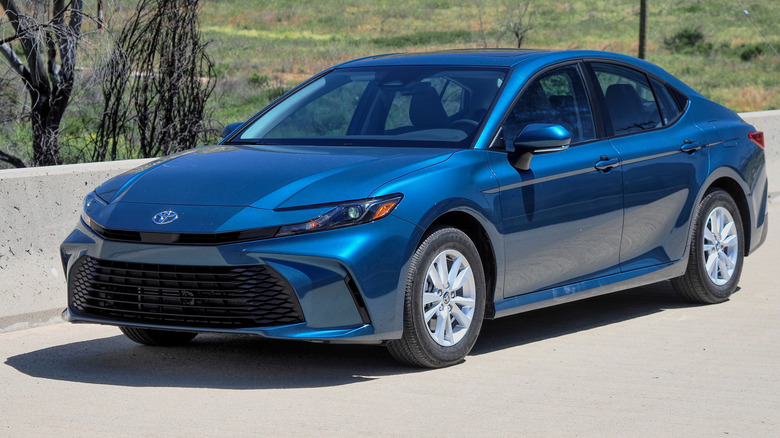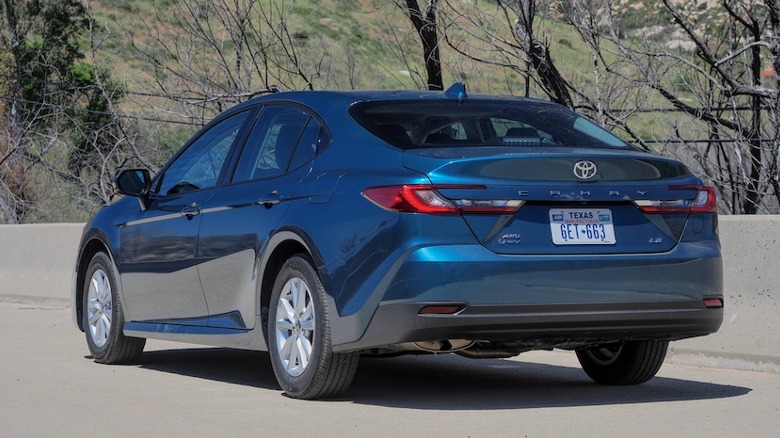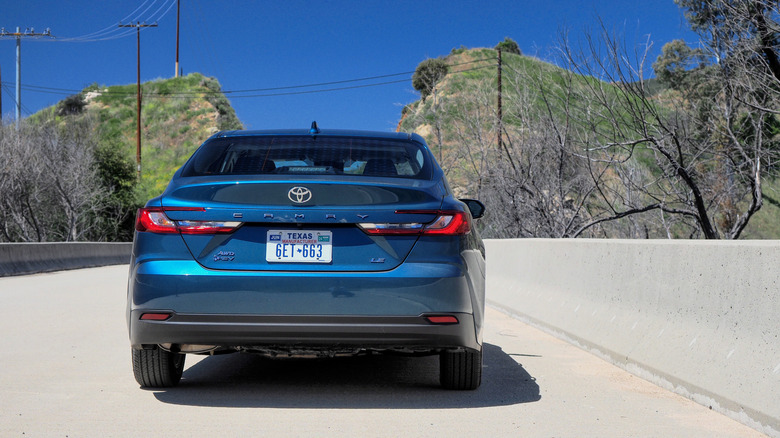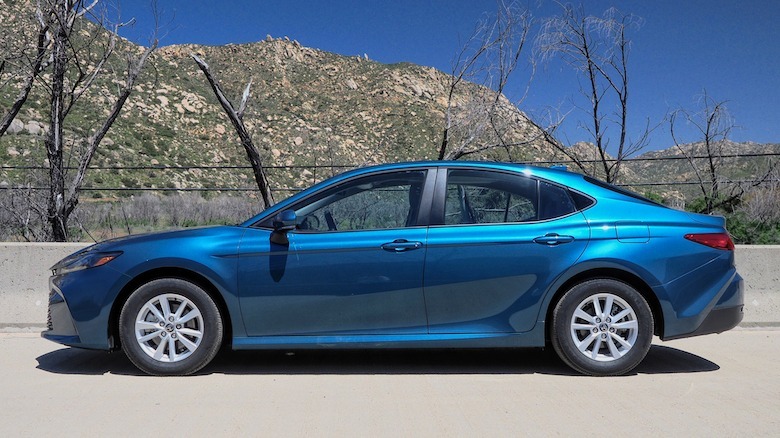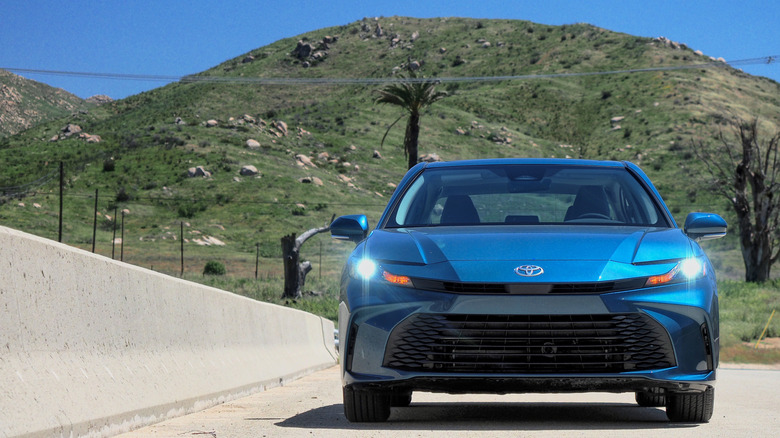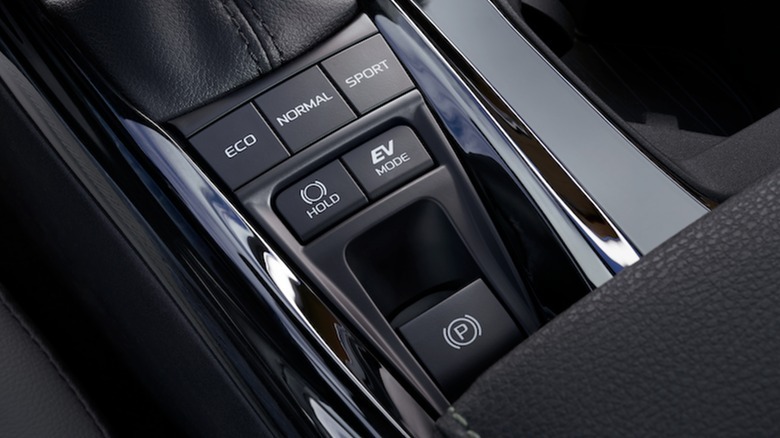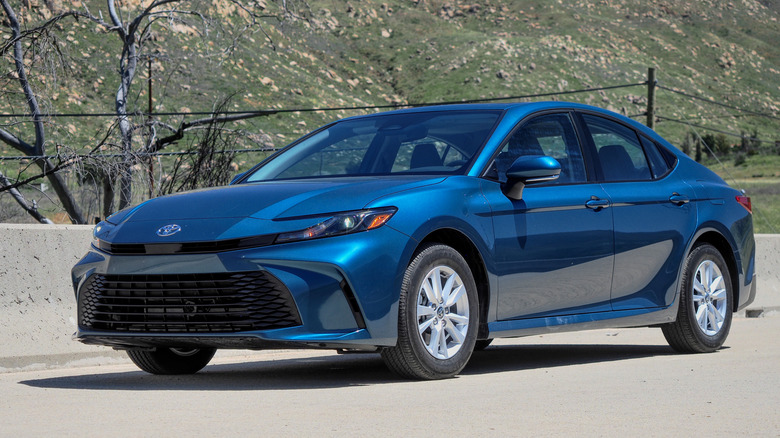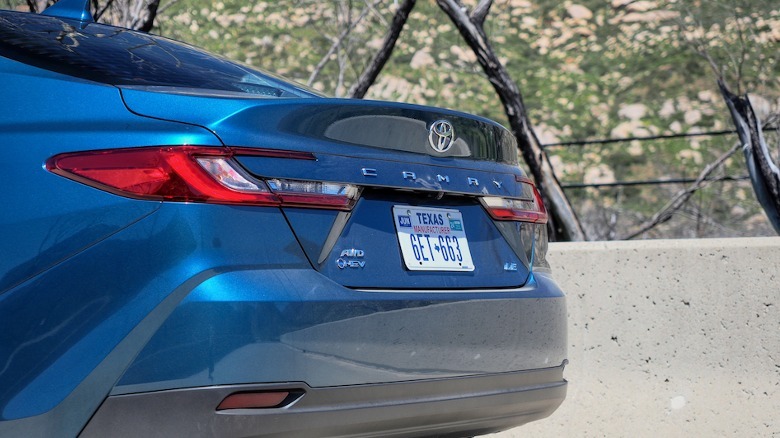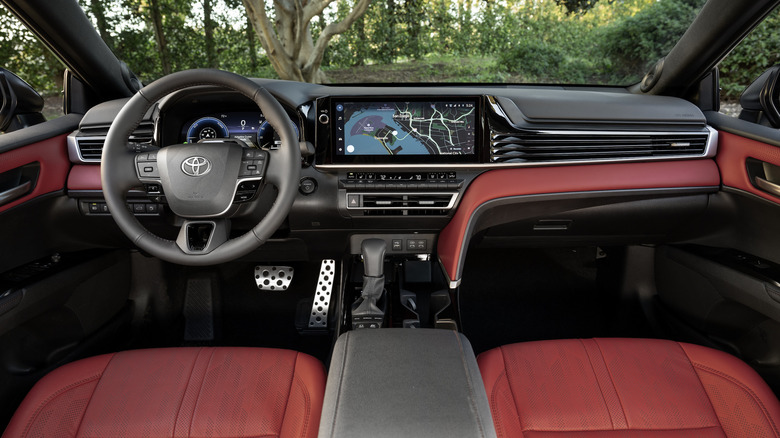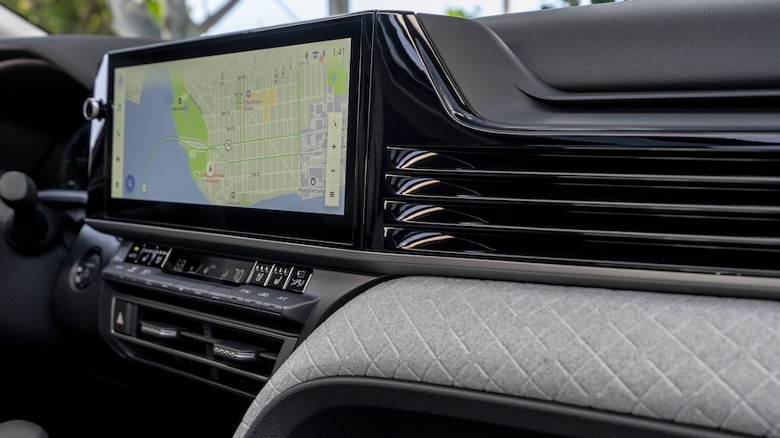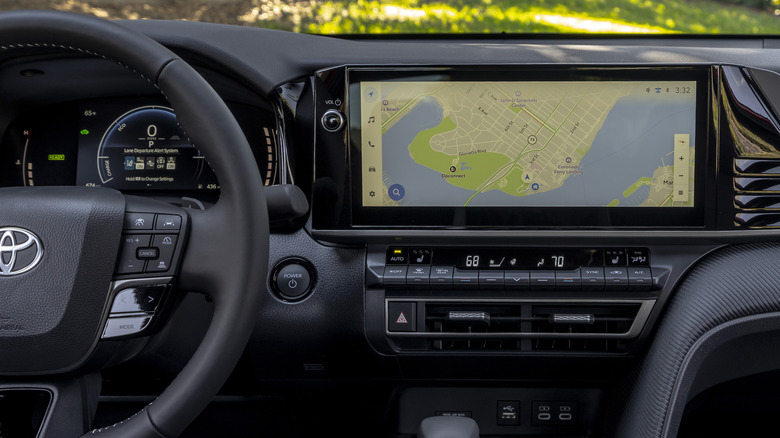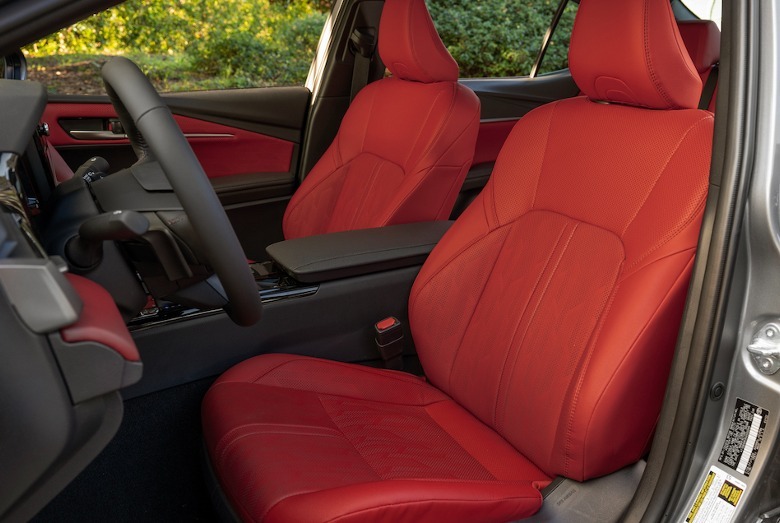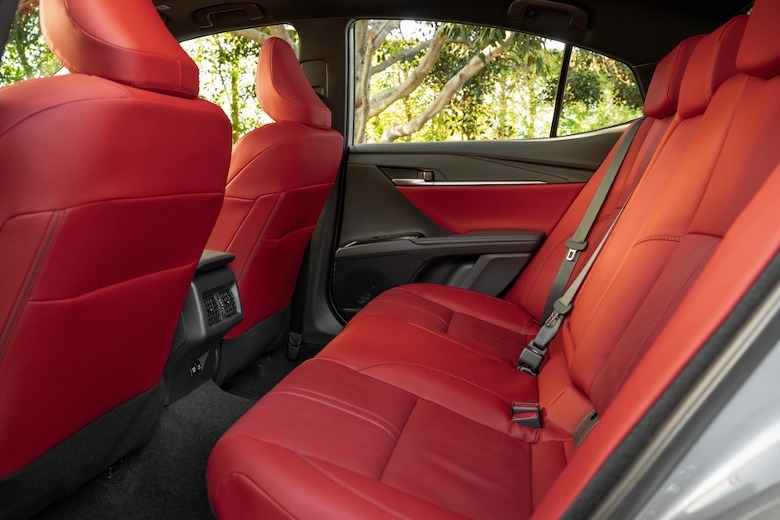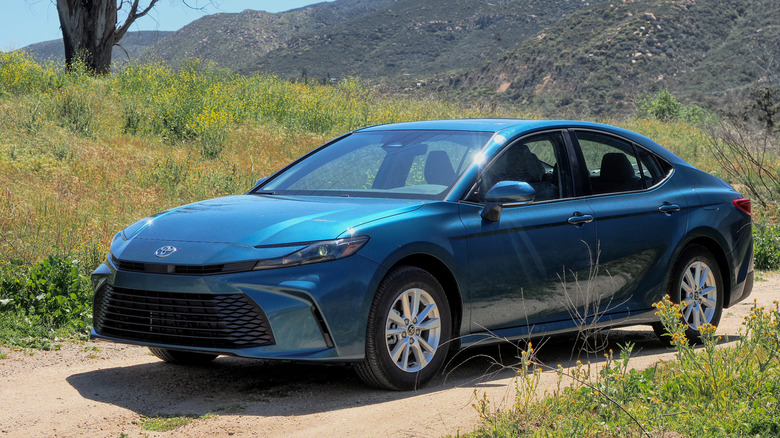2025 Toyota Camry First Drive: Affordable Hybrid Sedan Comes With A Surprise
For a car decried by some as more appliance than vehicle, intended for drivers not all that interested in, well, driving, the Toyota Camry had become pretty confusing. Six trims, multiple engines, an optional hybrid, and an available AWD (but not on every variant) left the popular sedan an oddly complicated prospect. For the ninth-generation 2025 Camry, Toyota has simplified things.
There are now just four trim grades — LE and XLE offering a more classic, luxury-inspired aesthetic, while SE and XSE take a sportier approach — and all use a gas-hybrid drivetrain. While front-wheel drive is standard, any of the four grades can be equipped with all-wheel drive, which also nudges the horsepower north slightly.
It's a far tidier, easier-to-understand approach than the old Camry, which came in front-wheel drive four-cylinder, hybrid, and V6 versions, and an all-wheel drive four-cylinder option, not all of which were available with each of the multiple equipment grades. Toyota has made it ever so slightly cheaper, too, with the 2025 Camry LE kicking off at $28,400 (plus $1,095 destination) compared to the $28,855 (plus destination) of the old 2024 Camry Hybrid LE.
Priced to sell, with hybrid as standard
You'll struggle to hit $40k with the 2025 Camry, though a cunning dealer could probably load you up with mats, mud flaps, and fluffy dice if you really wanted to. The Camry SE FWD is $30,700, the XLE FWD starts at $33,400, and the XSE FWD at $34,600 (all plus destination).
Adding all-wheel drive to each is $1,525, and that doesn't seem bad at all considering what you get. The standard Camry gets Toyota's fifth-generation hybrid system, pairing a 2.5-liter inline-four gas engine with a pair of electric motors, to drive the front wheels. It's actually the first implementation in the automaker's line-up of this particular configuration: though the newest Prius is also a fifth-gen system, it has a smaller, 2.0-liter gas engine.
In the Camry hybrid, the result is 225 horsepower combined. For the all-wheel drive version, Toyota adds a dedicated third electric motor to drive the rear axle. That also bumps the total system power to 232 hp. Either way, there's an electronically controlled continuously variable transmission (CVT) and nowhere to plug in: this is a regular hybrid, not a PHEV.
The result is up to an EPA-estimated 51 mpg combined from the Camry LE FWD, with the AWD version dropping only a point to 50 mpg. The front-wheel drive SE, XSE, and XLE land at 47 mpg combined, with the all-wheel drive SE and XLE at 46 mpg. Even at its thirstiest, in XSE AWD form, the Camry should still do 44 mpg combined.
Wait, a Camry you'll look forward to driving?
Toyota reps may make pained noises if you suggest it, but expectations for the Camry as a sporting sedan were always fairly humble. Old TRD trim aside, the four-door's aspirations invariably fell more on the "affordable transportation" side of things. The good news is, though, that lower expectations make for all the more pleasant surprises.
No, the 2025 Camry is not going to be your first choice for backroad mayhem, but it definitely outperforms what you'd predict from it. Toyota says the suspension has been returned versus the old car, with MacPherson strut front suspension and a multi-link rear system; the SE and XSE grades also get new shock absorbers along with larger front stabilizer bars. All four trims get a choice of Normal, Eco, and Sport drive modes.
The result is compliant and capable, and perhaps far more than (almost) any Camry driver expects or requires. "Balanced" is arguably the best descriptor. It's plenty fast enough, never feeling like it's lagging. The transition between electric and gas power, and regenerative and physical braking, is seamless; the sedan's electrically-assisted steering is light, but not vague. There's no churning body roll as you zip between corners, and no weirdly out-of-place groaning or surging from the gas engine, like the Prius' ICE component sometimes interjects.
Striking from the front, unmemorable from the back
It's the front where the Camry's aesthetic is most obviously changed, the sedan following the Prius not only in embracing hybrid electrification but also borrowing a version of its fascia. The "hammerhead" design — a version of which we've seen on the Toyota Crown, too — is a conspicuous step away from the old, eighth-generation Camry, ditching the droopy snout and looking all the more purposeful for it. All grades get LED daytime running lights, but only the fancier XLE and XSE grades have the upgraded dual-LED projector headlamps.
By the time you reach the rear, however, Toyota's redesign feels like it has run out of steam. Side by side with the old car, the differences are clear — including how the trunk-spanning "CAMRY" bar now intersects the standard LED taillight clusters — but, glanced at on the road, it's tougher to distinguish the changes. Passers-by are probably going to need to step around to the front in order to be sure they're looking at a 2025 Camry.
16-inch alloy wheels are standard on the LE (cheaper trims of the old Camry still languished on steel wheels), kicking up to 18 inches on the SE and XLE, and 19 inches on the XSE. The sportier SE and XSE versions get chrome tips on their tailpipes and fancier side rocker panels; the XSE adds a black rear spoiler, while the SE has a body-color version. Only the 2025 Camry XSE can be had in two-tone paint.
The interior gets the big design glow-up
Inside, Toyota's 2025 updates are even more impressive. Gone is the old fake wood and metal-effect plastic, along with a touchscreen that perched atop the dashboard like a clunky afterthought. In their place are cleanly integrated tech and an enthusiastic embrace of materials that aren't pretending to be something they're not.
That means the seat fabrics — cloth on the LE, SofTex, and fabric on the SE, leather and microfiber on the XLE, and leather on the XSE — wrap around into the door panels and then onto the dashboard trim. Toyota's style isn't outlandish; there are no self-indulgent (and rapidly dated) swoops or flourishes. Just straightforward controls for the standard dual-zone climate control, standard keyless entry and start, and new-to-Camry options like power seat memory and auto-wipers on the XSE.
Heated front seats are optional on the LE and SE, and standard on the XLE and XSE; the latter two grades can optionally be equipped with ventilated front seats. Between the front seats is an easily navigated set of controls for the three drive modes, toggling the standard auto brake-hold (always a handy inclusion), and switching on EV mode. The latter only works at very low speeds, mind, and for small distances: the mild-hybrid Camry really isn't designed to replace a pure EV.
More tech for your money
The Camry XLE and XSE also offer an optional panoramic glass roof option — a first for Camry — while all grades get blind spot warnings along with Toyota Safety Sense 3.0. That includes pre-collision assist with pedestrian detection, adaptive cruise control, lane-departure alerts with steering assist, lane tracing assist, proactive driving assist, and automatic high-beams. XLE and XSE have optional 360-degree cameras, front cross-traffic alerts and lane change assist, rear cross-traffic auto-braking, and front and rear parking sensors.
2025 Camry LE and SE grades have an 8-inch touchscreen running Toyota's solid infotainment system and a 7-inch driver display. XLE and XSE upgrade that to a 12.3-inch touchscreen and a 12.3-inch fully-digital cluster, plus an optional head-up display. Either way, wireless Apple CarPlay and Android Auto are standard across the board, as is a wireless phone charging pad (if the Camry can have that, Toyota, why not the new Land Cruiser 1958 at roughly twice the price?), 6-speaker audio, and five USB ports (one USB-A media and two USB-C power ports in the front, and USB-A and USB-C power ports in the back).
Options include a 9-speaker JBL audio system with a subwoofer, along with a digital key for access to the Camry from your phone. The XLE and XSE trims throw in the front side noise-reducing glass along with the standard acoustic noise-reducing windshield. All benefit from an admirable warranty, too.
Better than the Camry needed to be
Automotive enthusiasts love to dismiss the Camry, but building a car that delivers the reliability and consistency of an appliance is harder than it sounds. Doubly so, when you're working to a strict budget. Camry buyers are demanding, even if theirs can be a different set of expectations from their ride.
On that basis, it's tough to argue with Toyota's decisions for the 2025 Camry. No, it's not a wholesale reinvention of the sedan, but then neither did it need to be. Instead, the automaker focused on changes that pack the most punch, like a better-equipped cabin that feels more cohesive, and a simplification of what had grown into a confusing array of trims and grades.
Arguably most important, though, is the swift and seamless hybrid drivetrain that delivers better economy without really demanding behavioral change. That's key for individual Camry owners, yes, but — given just how many Toyota sells each year — represents a whole lot more frugal hybrids hitting the roads compared to gas-only vehicles. That the 2025 Camry manages to be unexpectedly appealing in its own right is just icing on that cake.
